The Flat Bottom Bags Market is estimated to be valued at USD 1.6 billion in 2025 and is projected to reach USD 2.6 billion by 2035, registering a compound annual growth rate (CAGR) of 4.7% over the forecast period.
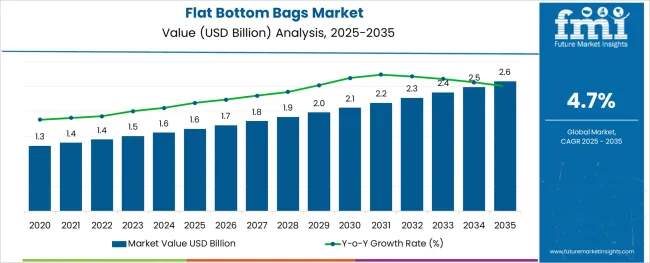
The flat bottom bags market is advancing steadily, supported by the growing emphasis on efficient packaging, superior shelf appeal, and sustainability across industries. Rising demand from food and beverage brands for packaging solutions that optimize storage, enhance branding visibility, and reduce environmental footprint is contributing significantly to the market’s momentum.
Advancements in material sciences and printing technologies have enabled manufacturers to offer more durable, aesthetically appealing, and eco-friendly options that align with evolving consumer expectations and regulatory requirements. Future growth is expected to be fueled by expanding retail footprints, increasing preference for convenient and resealable packaging formats, and heightened corporate focus on recyclable and lightweight materials.
Collaborations between converters and brand owners and innovation in high-barrier materials are paving the way for long-term adoption and market expansion.
The market is segmented by Material, Capacity Type, and End-User and region. By Material, the market is divided into Plastic and Paper. In terms of Capacity Type, the market is classified into 50-150 OZ, Less than 50 OZ, and More than 150 OZ.
Based on End-User, the market is segmented into Food & Beverage, Cosmetics & Personal Care, Pharmaceuticals, Agriculture, and Other Consumer Goods. Regionally, the market is classified into North America, Latin America, Western Europe, Eastern Europe, Balkan & Baltic Countries, Russia & Belarus, Central Asia, East Asia, South Asia & Pacific, and the Middle East & Africa.
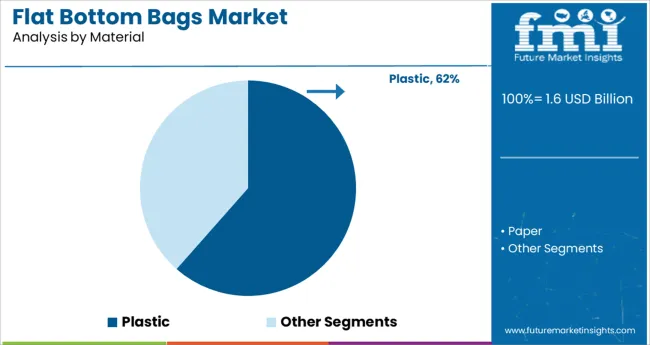
When segmented by material, plastic is expected to account for 61.5% of the total market revenue in 2025, making it the leading material segment. This dominance is attributed to the material’s versatility, cost efficiency, and ability to provide high-barrier protection against moisture, oxygen, and contaminants.
Plastic flat bottom bags have been widely adopted as they offer superior durability and sealing properties that maintain product freshness and integrity over extended shelf life. The ability to support complex printing and finishing techniques has allowed brands to leverage plastic bags for enhanced visual appeal and differentiation in competitive retail environments.
Lightweight construction and compatibility with automated filling equipment have also improved operational efficiency, further solidifying plastic’s leadership in the market.
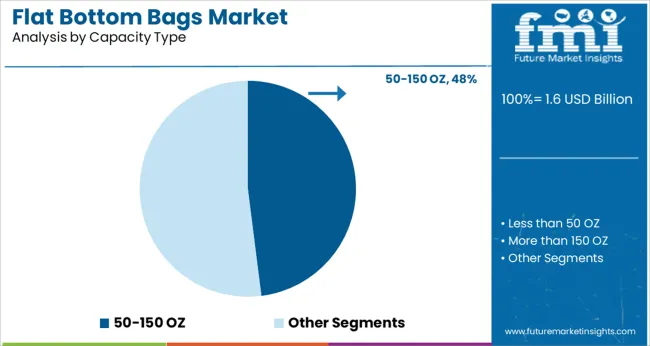
In terms of capacity type, the 50 to 150 OZ segment is projected to hold 48.0% of the market revenue in 2025, establishing itself as the dominant capacity range. This leadership is driven by its suitability for a wide variety of products, offering the right balance between portability, convenience, and cost-effectiveness.
The segment has gained preference among manufacturers and retailers for efficiently catering to household and institutional packaging needs without compromising ease of handling. Its ability to accommodate both dry and semi-liquid goods while maintaining package integrity and minimizing material waste has been a decisive factor in its widespread adoption.
Furthermore, the segment aligns well with consumer demand for mid-sized, resealable, and space-efficient packages that fit modern lifestyles and storage constraints.
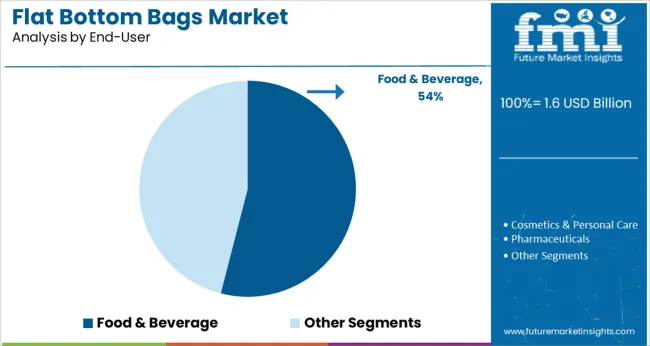
When segmented by end user, food and beverage is forecast to capture 54.0% of the total market revenue in 2025, retaining its position as the top industry segment. This prominence is reinforced by the sector’s constant demand for packaging solutions that ensure product safety, extend shelf life, and create a premium consumer experience.
Flat bottom bags have become a preferred choice due to their ability to stand upright, maximize shelf utilization, and showcase branding effectively, which is crucial in crowded retail spaces. The segment has also benefited from rising consumption of packaged foods, snacks, coffee, and specialty beverages that require both aesthetic appeal and functional performance.
Increasing focus on portion control, convenience, and sustainability in the food and beverage sector has further supported the adoption of flat bottom bags as an efficient and attractive packaging solution.
The global flat-bottom bags market witnessed a growth rate of 4.4% CAGR during 2020 to 2025 and reached USD 1.6 Billion in 2025.
Flat-bottom bags have been a relatively well-liked sort of bag for packaging coffee. The shape of this particular bag is rectangular. The pouch's bottom is sealed and gusseted from the sides.
To enable the bag to stand up upright on shelves, the bag's vertical sides have been creased. The flat bottom bags are widely used in the food and beverage industry.
There is an increasing trend for packed food which drive the flat-bottom bags market. changing consumer lifestyle, increasing urbanization and increasing disposal income create higher demand for flat-bottom bags.
The adoption of the food industry drives the demand for flat-bottom bags. The increased online food orders create growth prospects for the global flat-bottom bags market. Overall, the global flat-bottom bags market is anticipated to register a CAGR of 4.7% during the forecast period.
Sales in the global food and beverage sector have been rising significantly. Supermarkets, department stores, and convenience stores all have a significant global penetration of retail outlets of all types.
Rapid urbanization, growing population, and increase in disposal income these factors are driving the food and beverage industry significantly.
A growing number of individuals prefer eating out to cooking at home due to the rise in households worldwide. The high demand for construction materials is a result of the high rate of urbanization in the area.
The opening of several new restaurants has increased the need for paper bags in the food and beverage industry worldwide.
These factors will create positive growth opportunities for the flat-bottom bags market over the period.
The based on material based segment, paper material segment is expected to hold 68% by the end of 2035.
The paper has offered various eco-friendly advantages as compared to other materials. Paper material is a recyclable and recyclable material. There are now really concerned about how pollution is impacting the environment as it is rising.
Therefore, many paper bag manufacturers are setting up their businesses to help in the effort to maintain the environment and the natural world. The environment would have benefited significantly from it.
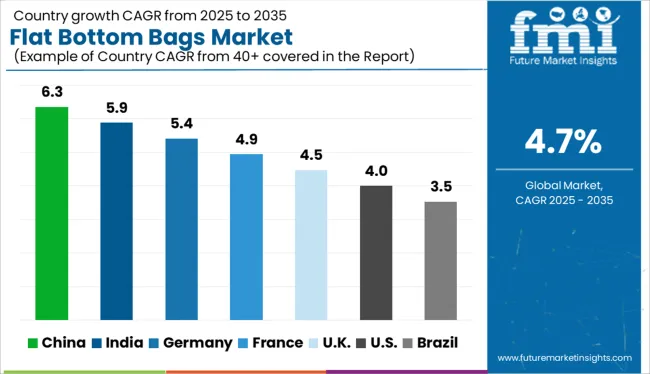
Indian flat bottom bags market is projected to grow 1.5 times the current market value during the forecast period due to the growing food service industry in India. According to the National Restaurant Association of India (NRAI), the Indian restaurant industry accounts for around USD 4 billion with more than 5 lakh restaurants in India. Thus, the expanding food service industry in India is the major factor driving the demand for the flat-bottom bags market in India.
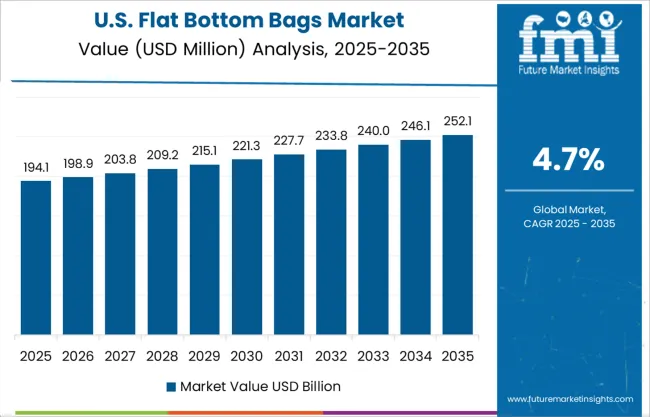
The USA is estimated to hold a major portion of the North American flat-bottom bags market during the forecast period.
The USA is estimated to account for around 79% of the North American flat-bottom bags market. The reason behind the same is USA consumers prefer recyclable and sustainable packaging solutions due to the increasing waste resulting in landfills.
According to the American Forest & Paper Association (AF&PA), in the USA, paper is one of the most widely recycled materials. The recyclability of paper packaging helps it gain traction among USA consumers and drives the demand for flat-bottom bags. Furthermore, the paper recycling rate in the USA has exceeded 63% since 2009.
Thus, the preference for recyclable, sustainable, and innovative packaging solutions is bolstering the demand for paper packaging including flat-bottom bags in the USA.
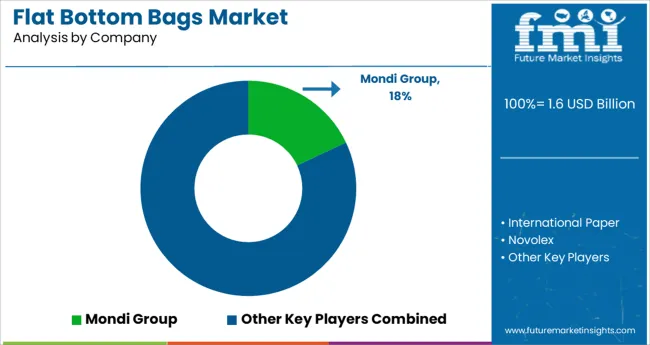
The key players operating in the flat-bottom bags market are trying to focus on increasing their sales and revenues by expanding their capabilities to meet the growing demand. The key players are trying to adopt a merger & acquisition strategy to expand their resources and are developing new products to meet customer needs. Also, the players are focusing on upgrading their facilities to cater to the demand.
Some of the recent key developments by the leading players are as follows -
| Attribute | Details |
|---|---|
| Growth Rate | CAGR of 4.7% from 2025 to 2035 |
| Base Year for Estimation | 2025 |
| Historical Data | 2020 to 2025 |
| Forecast Period | 2025 to 2035 |
| Quantitative Units | Revenue in million, Volume in tons, and CAGR from 2025 to 2035 |
| Report Coverage | Revenue Forecast, Volume Forecast, Company Ranking, Competitive Landscape, Growth Factors, Trends, and Pricing Analysis |
| Segments Covered | Material, Capacity Type, End-users |
| Regions Covered | North America; Latin America; Europe; East Asia; South Asia; Middle East and Africa; Oceania |
| Key Countries Covered | United States of America, Canada, Germany, Italy, France, United Kingdom, Spain, Russia, Poland, Turkey, South Africa, GCC Countries, Japan, South Korea, India, China, Australia, New Zealand |
| Key Companies Profiled | Mondi Group; International Paper; Novolex; Smurfit Kappa; Pouch Makers; Layfield Flexible Packaging; Tekpak Solutions; DXC Packaging; PBFY Flexible Packaging; Pack Plus; Knack Packaging; Fine Packaging |
| Customization & Pricing | Available upon Request |
The global flat bottom bags market is estimated to be valued at USD 1.6 billion in 2025.
It is projected to reach USD 2.6 billion by 2035.
The market is expected to grow at a 4.7% CAGR between 2025 and 2035.
The key product types are plastic and paper.
50-150 oz segment is expected to dominate with a 48.0% industry share in 2025.






Full Research Suite comprises of:
Market outlook & trends analysis
Interviews & case studies
Strategic recommendations
Vendor profiles & capabilities analysis
5-year forecasts
8 regions and 60+ country-level data splits
Market segment data splits
12 months of continuous data updates
DELIVERED AS:
PDF EXCEL ONLINE
Flat Bag Back-blowing Dust Collector Market Size and Share Forecast Outlook 2025 to 2035
Flatback Tape Market Size and Share Forecast Outlook 2025 to 2035
Flat Rack Containers Market Size and Share Forecast Outlook 2025 to 2035
Flatting Agents Market Size and Share Forecast Outlook 2025 to 2035
Flatbed Die Cutters Market Size and Share Forecast Outlook 2025 to 2035
Flat Panel Antenna Market Size and Share Forecast Outlook 2025 to 2035
Flatbed Trucks Market Size and Share Forecast Outlook 2025 to 2035
Flat Valve Caps And Closures Market Size and Share Forecast Outlook 2025 to 2035
Flat Glass Market Growth & Demand 2025 to 2035
Flat Panel Display Market Analysis by Technology, Application, and Region through 2025 to 2035
Flatware Market Analysis - Growth & Demand Forecast 2025 to 2035
Flat Panel X-Ray Detectors Market Analysis by Application, Product, and Region Forecast Through 2035
Analyzing Flatback Tape Market Share & Industry Leaders
Market Share Insights of Leading Flat Glass Coating Providers
Flat Steel Market Growth – Trends & Forecast 2024-2034
Flatware Holders and Organizers Market
Flat Bottom Pouch Market Size and Share Forecast Outlook 2025 to 2035
Leading Providers & Market Share in Flat Bottom Pouch Manufacturing
Aflatoxicosis Treatment Market Growth – Trends & Forecast 2025 to 2035
Inflatable Tent Market Size and Share Forecast Outlook 2025 to 2035

Thank you!
You will receive an email from our Business Development Manager. Please be sure to check your SPAM/JUNK folder too.
Chat With
MaRIA